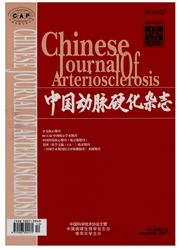

 中文摘要:
中文摘要:
目的 探讨阿托伐他汀能否抑制高迁移率族蛋白1(HMGB1)诱导的血管内皮细胞激活,阐明其潜在的分子机制。方法 体外培养大鼠胸主动脉内皮细胞,分别用不同浓度的阿托伐他汀、HMGB1、TLR4特异性抑制剂CLI-095预处理内皮细胞,荧光定量分析中性粒细胞与内皮细胞的黏附活力;实时定量RT-PCR与Western blot分别检测TLR4、细胞间黏附分子1(ICAM-1)和E-选择素mRNA和蛋白的表达水平;电泳迁移率实验(EMSA)测定核因子κB(NF-κB) p65的DNA结合活性。结果 阿托伐他汀(0.1~10 μmol/L)呈剂量依赖性地抑制HMGB1诱导的血管内皮细胞活化。阿托伐他汀预处理能明显下调HMGB1诱导的TLR4 mRNA和蛋白表达水平(P均〈0.05);阿托伐他汀、CLI-095均能有效抑制HMGB1诱导的NF-κB p65的DNA结合活性以及ICAM-1和E选择素的表达水平(P均〈0.05)。结论 阿托伐他汀可通过调节黏附分子(ICAM-1和E-选择素)的表达而显著抑制HMGB1诱导的血管内皮细胞活化效应,其机制可能与它抑制TLR4的表达及NF-κB激活有关。
 英文摘要:
英文摘要:
Aim To explore whether atorvastatin inhibits HMGB1-induced vascular endothelial activation, and clarify the underlying molecular mechanism. Methods The cultured endothelial cells (EC) of rats were treated by Atorvastatin, HMGB1,TLR4-specific inhibitor CLI-095 with different concentrations. Leukocyte-endothelial adhesion was calculated as the proportion of the adherent neutrophils fluorescence intensity among the total added cells. RT-PCR and Western blot method were used to assay the expression of Toll like receptor 4(TLR4), ICAM-1 , E-selectin mRNA and protein. DNA binding activity of NF-κB was measured by EMSA. Results Atorvastatin, at concentrations ranging from 0.1 to 10 μmol/L, effectively and in a dose-dependent manner inhibited HMGB1-induced ECs activation. Atorvastatin markedly suppressed TLR4 expression (P〈0.05) in ECsIncubation of ECs with atorvastatin and CLI-095 reduced HMGB1-induced NF-κB p65 DNA binding activity and adhesion molecules (ICAM-1 and E-selectin) expression (P〈0.05). Conclusion Atorvastatin can attenuate HMGB1-induced vascular endothelial activation. The underlying mechanism may be connected with inhibition of TLR4/NF-κB-dependent signaling pathway induced leukocyte-endothelial adhesion.
 同期刊论文项目
同期刊论文项目
 同项目期刊论文
同项目期刊论文
 High mobility box 1 mediates neutrophil recruitment in myocardial ischemia-reperfusion injury throug
High mobility box 1 mediates neutrophil recruitment in myocardial ischemia-reperfusion injury throug The HMGB1-TLR4 axis contributes to myocardial ischemia/reperfusion injury via regulation of cardiomy
The HMGB1-TLR4 axis contributes to myocardial ischemia/reperfusion injury via regulation of cardiomy RP105 Protects Against Apoptosis in Ischemia/Reperfusion- Induced Myocardial Damage in Rats by Suppr
RP105 Protects Against Apoptosis in Ischemia/Reperfusion- Induced Myocardial Damage in Rats by Suppr Radioprotective 105 kDa protein (RP105): is a critical therapeutic target for alleviating ischemia r
Radioprotective 105 kDa protein (RP105): is a critical therapeutic target for alleviating ischemia r Resveratrol pretreatment protects rat hearts from ischemia/reperfusion injury partly via a NALP3 inf
Resveratrol pretreatment protects rat hearts from ischemia/reperfusion injury partly via a NALP3 inf RP105 protects against myocardial ischemia-reperfusion injury via suppressing TLR4 signaling pathway
RP105 protects against myocardial ischemia-reperfusion injury via suppressing TLR4 signaling pathway MicroRNA-22 targeting CBP protects against myocardial ischemia-reperfusion injury through anti-apopt
MicroRNA-22 targeting CBP protects against myocardial ischemia-reperfusion injury through anti-apopt 期刊信息
期刊信息
